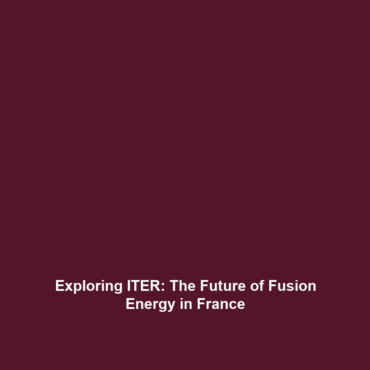Notable Projects: The Wendelstein 7-X in Germany
Introduction
The Wendelstein 7-X is an innovative stellarator project based in Germany, designed to advance the field of fusion energy by addressing some of the long-standing stability challenges faced by tokamaks. As a leading research facility, the Wendelstein 7-X aims to provide crucial insights that could facilitate the development of a viable fusion energy system, which has the potential to revolutionize global energy production through safe, clean, and nearly limitless energy sources.
Key Concepts
Understanding Stellarators and Tokamaks
The Wendelstein 7-X represents a significant evolution in the pursuit of fusion energy. Unlike tokamaks, which rely on magnetic fields to confine plasma, stellarators use twisted magnetic configurations to achieve plasma stability. This novel approach offers several advantages, including:
- Improved Plasma Stability: The stellarator design minimizes the risk of disruptions that can occur in tokamak systems.
- Longer Pulse Durations: Stellarators can potentially operate continuously, unlike tokamaks, which are often limited to short operational periods.
- Greater Flexibility: The design allows for variations in plasma configuration, providing more experimental opportunities.
Applications and Real-World Uses
The Wendelstein 7-X showcases promising applications in the growing field of fusion energy. The insights gained from this project can lead to practical implementations such as:
- Electric Power Generation: By harnessing the principles of nuclear fusion, the Wendelstein 7-X aims to contribute to the development of clean and sustainable energy production.
- Medical Uses: Advances in plasma technology potentially benefit fields like cancer treatment and medical imaging.
- Industrial Applications: The knowledge obtained from stellarator research could improve materials processing techniques used in various industries.
Current Challenges
Despite its advancements, the Wendelstein 7-X faces several challenges in the quest for effective fusion energy solutions. Key issues include:
- Technical Complexity: Designing and operating stellarators is more complex than tokamaks, posing engineering challenges.
- Cost Considerations: The high financial investment required for ongoing research and infrastructure development is significant.
- Public Perception: Misunderstandings about fusion technology can lead to skepticism regarding its feasibility and safety.
Future Research and Innovations
Looking forward, the Wendelstein 7-X is expected to drive several groundbreaking research initiatives and innovations in fusion energy. Some anticipated advances include:
- Next-Gen Materials: Development of advanced materials that can withstand extreme conditions in fusion reactors.
- Integration with Renewable Energy: Exploring ways to incorporate fusion-derived energy with existing renewable systems to create hybrid solutions.
- Advanced Computational Models: Improved simulations to predict plasma behavior and optimize reactor design.
Conclusion
The Wendelstein 7-X is a cornerstone project in the journey toward practical fusion energy, addressing significant issues within traditional tokamak systems and paving the way for sustainable energy solutions. As research progresses, the potential applications of this remarkable project continue to expand, raising hopes for a future where fusion energy becomes a reality. To learn more about related fusion projects, consider exploring:
- Additional Fusion Research Initiatives
- Understanding Tokamak Systems
- The Role of Fusion in Renewable Energy

